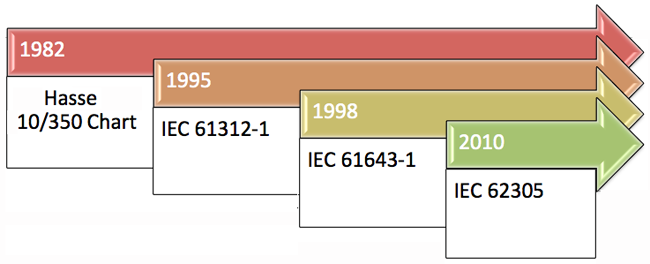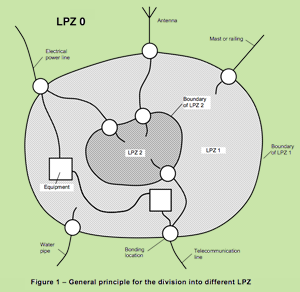TEN350 The waveform that hijacked the IEC lightning standards
IEC 62305-4
NAME:
Protection against lightning - Part 4: Electrical and electronic systems within structures.
AUTHORS:
IEC Technical Committee TC 81 Lightning Protection.
INFO:
The 10/350 waveform is the engine that drives this standard. SPDs are chosen solely based on the 10/350 waveform. Lightning protection zones are designated solely based on the 10/350 wave form. Lightning Protection Levels are assigned solely on the basis of the 10/350 waveform. One third of the standard consists of coordination strategies made necessary solely because of the 10/350 waveform. If you removed the influence of the 10/350 waveform from this standard what would remain would be the information on earthing, bonding, & shielding.
TIMELINE FOR CLASS I TEST PARAMETERS:

1982: Hasse 10/350 Chart
1995: IEC 61312-1 (parameters come directly off the Hasse 10/350 chart)
1998: IEC 61643-1 (parameters taken from IEC 61312-1)
2010: IEC 62305 Series references IEC 61643-1 and takes the Hasse lightning parameters unchanged from IEC 61312-1. Here are only some of those mentions in 62305-1 but they are repeated in many ways all through the 62305 series.
ANOMALIES IN 62305-4:

10/350 - "primary source of harm"
This standard tells us clearly that it considers the 10/350 waveform to be the "primary source of harm." Read what it says about that here.
That is the target against which all the 62305 major strategies and requirements are aimed.
The point is, if the 10/350 waveform doesn't really exist, is this standard mainly swatting at ghosts?
SPD requirement
Modern electronic equipment can only survive within a relatively narrow voltage range. Too high, and it will fry!!! A circuit that runs off a nominal voltage of 220 volts will not survive a surge of 10,000 volts. That's why lightning is such a serious threat to electronic systems. And that's why lightning protection should employ surge protectors capable of rapidly responding to large lightning currents clamping the overvoltages down to levels safe enough for the downstream equipment. MOV SPDs do exactly that. Conversely, spark gap SPDs (aside from their other problems) react far too slowly and allow too much voltage and current to get past them, so are not a good choice for protecting electronic equipment. (Read more here.) Despite all logic to the contrary, this standard specifies the use of spark gaps to play the principal role in protecting sensitive electronics. That is the first strike against it.
SPD coordination
This standard requires the use of spark gaps for one reason and one reason only: they can pass high amplitude 10/350 tests. Because spark gaps cannot provide a low enough protection level to alone protect electronic equipment the standard must also specify the use of MOVs. But because of the problems in coordination that exist in trying to mix these two technologies, it is compelled to then spend fully 1/3 of its pages trying to mitigate those problems. More information on SPD coordination can be found here.
In the parlance of this standard there are no such thing as "SPDs." There are only "coordinated SPDs." That's kind of like hanging out your dirty laundry on the day the Presidential parade is driving past your house.

LPZs-Lightning Protection Zones
This standard starts by introducing the concept of lightning protection zones with the diagram to the right. Its importance is underscored with the statement that the protection of electronic equipment from lightning "is based on the lightning protection zone (LPZ) concept." Pretty important stuff. So what does this mean? The green color (LPZ Zone 0) is meant to represent the entire area outside of a building and is called "Zone Zero." According to LPZ theory, direct lightning that hits anywhere in the green will produce a 10/350 waveform. What follows on from that is that only spark gap SPDs (which can survive the Class One 10/350 Test) are allowed to be installed at the boundaries between Zone Zero (the green) and Zone One (the building). The 10/350 waveform can thus be seen to be the entire basis on which the LPZ system is based. And if, as has been made clear by CIGRE's 2013 Technical Brochure 549 and as shown elsewhere in this web, that there is no relation whatsoever between lightning and the 10/350 waveform, that kind of leaves the LPZ theory on top of the Empire State Building without a lightning rod...
Vital data on LPZ system here.
Lightning PMS
Lightning PMS is another descriptive term coined by the standard writers in TC 81. Section 1 of the original 62305-4 tells us that the scope of this part of the standard includes the "information for the design, installation, inspection, maintenance, and testing" of Lightning PMS. According to Section 8.1 The first step of Lightning PMS is a Risk Assessment as per 62305-2. Risk Management is beyond the scope of this website, but anyone who's ever tried to actually use 62305-2 knows it is hopelessly complicated. A member of TC 81 told us in March 2013 (on the condition of anonymity) that he was certain that less than 5% of trained electrical engineers would be able to use the full procedure. We would add that of that 5%, most would have little inclination to do so. With that introduction, we hope it will make sense if we say that Lightning PMS probably describes the headaches caused to those trying to apply it and the hot flashes that must be endured by the equipment being "protected" by it. In the 2010 edition there seems to be a typo. Lightning PMS is spelled as "SPM". Not a big deal. We still knew what they were referring to.
Simple solution. The source of all the above anomalies is the imposition of the arbitrary and unhelpful 10/350 waveform into standards. If it were simply removed, all the above problems would vanish.
Back to IEC standards page